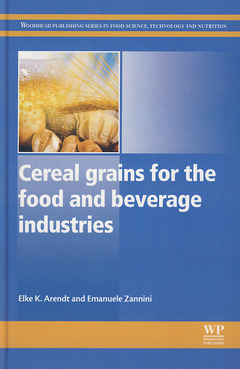Description
Cereal Grains for the Food and Beverage Industries
Woodhead Publishing Series in Food Science, Technology and Nutrition Series
Language: English
Subject for Cereal Grains for the Food and Beverage Industries:
512 p. · 15.5x23.2 cm · Hardback
Description
/li>Contents
/li>Biography
/li>Comment
/li>
Author contact details
Woodhead Publishing Series in Food Science, Technology and Nutrition
Foreword
Preface
Chapter 1: Wheat and other Triticum grains
Abstract:
1.1 Introduction
1.2 Structure of wheat grain
1.3 Wheat carbohydrate composition and properties
1.4 Wheat protein composition and properties
1.5 Other constituents of wheat
1.6 Flour milling
1.7 Bakery products based on wheat
1.8 Durum wheat products
1.9 Products based on other types of wheat
1.10 Beverages based on wheat
1.11 Conclusions
1.12 Future trends
Chapter 2: Maizes
Abstract:
2.1 Introduction
2.2 Maize carbohydrate composition and properties
2.3 Other constituents of the maize kernel
2.4 Maize processing
2.5 Applications of maize in foods
2.6 Applications of maize in beverages
2.7 Conclusions
2.8 Future trends
Chapter 3: Rice
Abstract:
3.1 Introduction
3.2 Rice carbohydrate composition and properties
3.3 Other constituents of the rice kernel
3.4 Rice processing
3.5 Food and beverage applications of rice
3.6 Conclusions
3.7 Future trends
Chapter 4: Barley
Abstract:
4.1 Introduction
4.2 Barley carbohydrate composition and properties
4.3 Other constituents of the barley kernel
4.4 Barley milling
4.5 Applications of barley in foods
4.6 Applications of barley in beverages
4.7 Conclusions
4.8 Future trends
Chapter 5: Triticale
Abstract:
5.1 Introduction
5.2 Chemical composition of the triticale kernel
5.3 Triticale milling and applications in foods and beverages
5.4 Conclusions
5.5 Future trends
Chapter 6: Rye
Abstract:
6.1 Introduction
6.2 Chemical constituents of the rye kernel
6.3 Rye milling and applications in foods and beverages
6.4 Conclusions
6.5 Future trends
Chapter 7: Oats
Abstract:
7.1 Introduction
7.2 Oat carbohydrate composition and properties
7.3 Other constituents of the oat kernel
7.4 Oat milling
7.5 Food and beverage applications of oats
7.6 Conclusions
7.7 Future trends
Chapter 8: Sorghum
Abstract:
8.1 Introduction
8.2 Chemical constituents of the sorghum kernel
8.3 Sorghum milling
8.4 Applications in foods and beverages
8.5 Conclusions
8.6 Future trends
Chapter 9: Millet
Abstract:
9.1 Introduction
9.2 Proso millet carbohydrate composition and properties
9.3 Proso millet protein composition and properties
9.4 Other constituents of proso millet
9.5 Processing of proso millet
9.6 Food and beverage applications of proso millet
9.7 Future trends
Chapter 10: Teff
Abstract:
10.1 Introduction
10.2 Chemical composition of the teff kernel
10.3 Teff milling and applications in foods and beverages
10.4 Conclusions
10.5 Future trends
Chapter 11: Buckwheat
Abstract:
11.1 Introduction
11.2 Buckwheat carbohydrate composition and properties
11.3 Buckwheat protein composition and properties
11.4 Other constituents of buckwheat
11.5 Food and beverage applications of buckwheat
11.6 Conclusions
11.7 Future trends
Chapter 12: Quinoa
Abstract:
12.1 Introduction
12.2 Chemical composition of quinoa seed
12.3 Quinoa milling and applications in foods and beverages
12.4 Conclusions
12.5 Future trends
Chapter 13: Amaranth
Abstract:
13.1 Introduction
13.2 Amaranth carbohydrate composition and properties
13.3 Other constituents of amaranth
13.4 Amaranth processing and applications in foods and beverages
13.5 Conclusions
13.6 Future trends
Index
Dr Emanuele Zannini is a Senior Research Scientist at the School of Food and Nutritional Sciences at University College Cork (UCC), Ireland.
- A comprehensive overview of all of the important cereal and pseudo-cereal species
- Chapters review each of the following species: Wheat, Maize, Rice, Barley, Triticale, Rye, Oats, Sorghum, Millet, Teff, Buckwheat, Quinoa and Amaranth
- Reviews grain structure, chemical composition, processing and applications in food and beverage products for each of the considered grains




